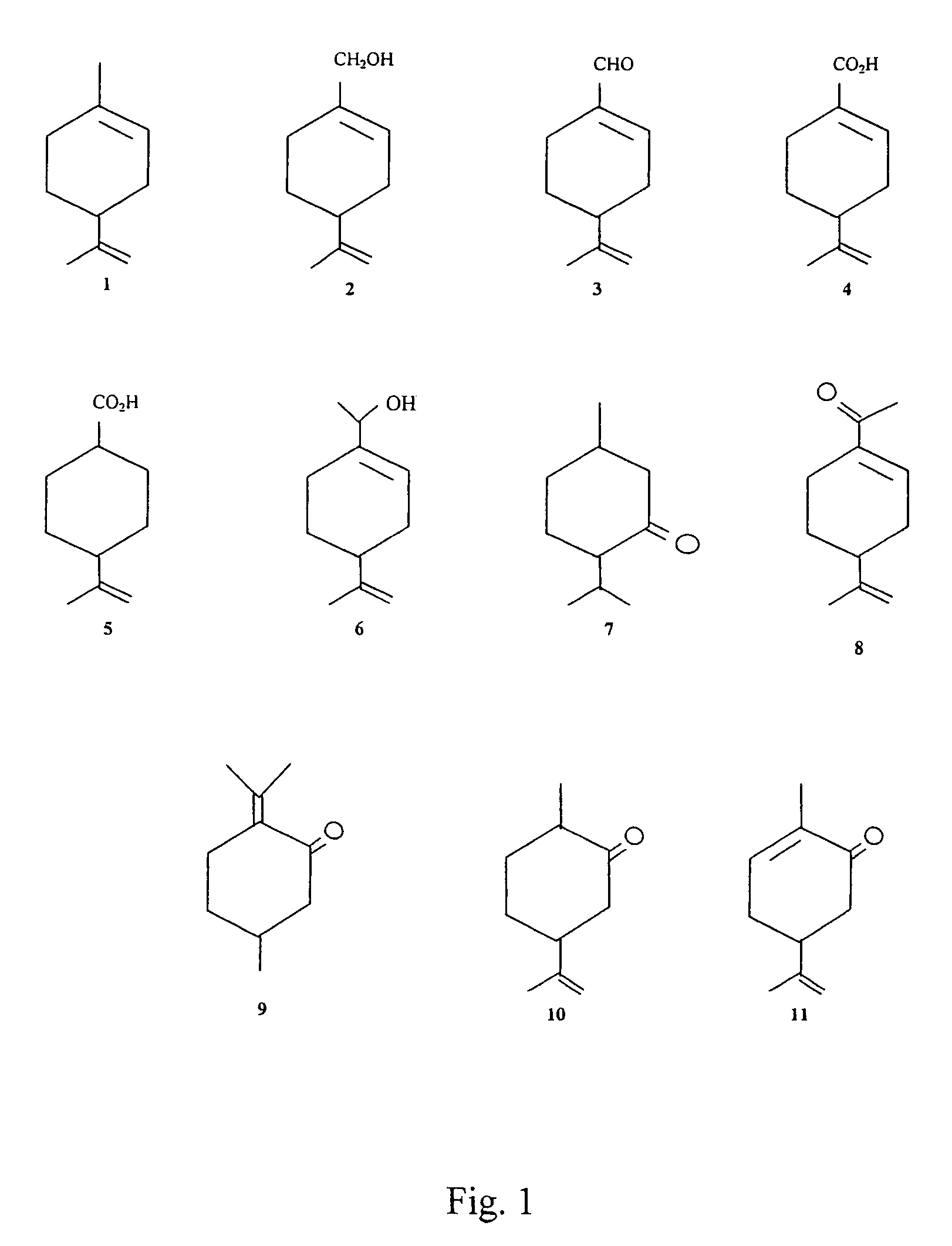Medical application of oxidized monoterpenes
a technology of oxidized monoterpenes and monoterpenes, which is applied in the field of treatment of fungal, bacterial, yeast and other growths, can solve the problems of limited effectiveness against fungi, inability to provide such clinical identification of microorganisms in certain treatments, and inability to cure diseases
- Summary
- Abstract
- Description
- Claims
- Application Information
AI Technical Summary
Benefits of technology
Problems solved by technology
Method used
Image
Examples
example 1
E. coli
[0028]Again, E. coli is one of the major causes of urinary tract infections as well as diarrhea, sepsis and meningitis. The formulations were exposed against cultures of E. coli showing growth inhibition.
[0029]About 1–2×106 cells of E. coli were exposed to 1% PCO, 1% PCO / 1% POH, 1% POH and 0.5% PCO / 0.5% POH formulations at 10, 30, and 60 minutes. Once the bacteria were exposed to formulations in the determined time, a 0.5 ml aliquot of exposition mix was used to inoculate 10 ml of TSB media and incubated at 35° C. for 18–24 hours. Absorbance (Abs.) measures were taken at 600 nm. After 10 minutes of exposure the bacterial growth was inhibited.
[0030]The following tables 1.1, 1.2, 1.3, and 1.4, show the responses for 1% PCO, 1% PCO / 1% POH, 1% POH and 0.5% PCO / 0.5% POH formulations, respectively.
[0031]
TABLE 1.11% PCO FormulationExposure timeE. coli Abs. 600 nm 0 minutes0.891210 minutes0.003230 minutes0.003360 minutes0.0019
[0032]
TABLE 1.21% PCO / 1% POH FormulationExposure timeE. c...
example 2
[0035]Pseudonoma aeruginosa (P. aeruginosa) is a well known pathogen which is the cause of infections in wounds and burns. It also causes meningitis and urinary tract infections. If it invades the bloodstream system, it may result in fatal sepsis, and skin infections causing necrosis and ecthyma gangrenosum.
[0036]About 1–2×106 cells of P. aeruginosa were exposed to 1% PCO, 1% PCO / 1% POH, 1% POH and 0.5% PCO / 0.5% POH formulation at 10, 30, and 60 minutes. Once the bacteria were exposed to formulation in the determined time, a 0.5 ml aliquot of exposition mix was used to inoculate 10 ml of TSB media and incubated at 35° C. for 18–24 hours. Absorbance measures were taken at 600 nm. After 10 minutes of exposure the bacterial growth was inhibited.
[0037]The following Tables 2.1, 2.2, 2.3, and 2.4, show the responses for 1% PCO, 1% PCO / 1% POH, 1% POH, and 0.5% PCO / 0.5% POH formulations, respectively.
[0038]
TABLE 2.11% PCO FormulationExposure timePs. Aeruginosa Abs. 600...
example 3
Burkholderia cepacea
[0042]Burkholderia cepacea (B. cepacea) is found in patients with cystic fibrosis, and other pulmonary infections.
[0043]About 1–2×106 cells of B. cepacea were exposed to 1% PCO, 1% POH 1% PCO / 1% POH, and 0.5% PCO / 0.5% POH formulations at 10, 30, and 60 minutes. Once the bacteria were exposed to formulation in the determined time, a 0.5 ml aliquot of exposition mix was used to inoculate 10 ml of TSB media and incubated at 35° C. for 18–24 hours. Absorbance measures were taken at 600 nm. After 10 minutes of exposure the bacterial growth was inhibited. B. cepacea exhibited a low growth of control cells. Nonetheless, the diminishing in the absorbance values and the lack of turbidity in the broth culture shows growth inhibition.
[0044]The following tables 3.1, 3.2, 3.3, and 3.4, show the responses for 1% PCO, 1% POH, 1% PCO / 1% POH, and 0.5% PCO / 0.5% POH, respectively.
[0045]
TABLE 3.11% PCO FormulationExposure timeB. cepacea abs. 600 nmControl0.153310 minutes0.011030 mi...
PUM
| Property | Measurement | Unit |
|---|---|---|
| time | aaaaa | aaaaa |
| time | aaaaa | aaaaa |
| concentration | aaaaa | aaaaa |
Abstract
Description
Claims
Application Information
 Login to View More
Login to View More - R&D
- Intellectual Property
- Life Sciences
- Materials
- Tech Scout
- Unparalleled Data Quality
- Higher Quality Content
- 60% Fewer Hallucinations
Browse by: Latest US Patents, China's latest patents, Technical Efficacy Thesaurus, Application Domain, Technology Topic, Popular Technical Reports.
© 2025 PatSnap. All rights reserved.Legal|Privacy policy|Modern Slavery Act Transparency Statement|Sitemap|About US| Contact US: help@patsnap.com

